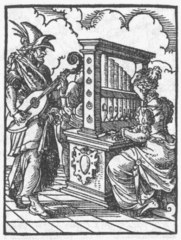In 1568 Jost Amman published his “Ständebuch”. The title is often translated as “Book of Trades”, but I think “Book of Classes” would better cover it.
 The first page of the book says it contains the following: 114 woodcuts, depicting a;
The first page of the book says it contains the following: 114 woodcuts, depicting a;
“Contemporary Description of all Classes on the Earth / Higher and Lower / Spiritual und Worldly / All Arts / Handicrafts und Trades / from the biggest to the smallest / Also from their Source / Experiences and Customs”.
Then they continue like a ringmaster in a circus or at an annual fair:
“By the worldfamous Hans Sachsen / very dilligent described / and captured in German Rhymes / Very useful and funny to read / and also with artful pictures / it’s equal was never seen by anybody before / all Classes Ständen so conceived in this book / for honor and pleasure / All Artists but / like painters / Goldsmiths / as a particular service worked out in Print”
In 114 woodcuts and little poems they describe all crafts and trades. As usual in those times they indexed the subject by social status and importance (the first one to break with this tradition would be Denis Diderot with his Encyclopedie, almost 200 years later). It statts with the Pope and bishop and goes down to Scribes, Brewers, Carpenters and at the lowest end a variety of Musicians and Jesters.
In the book the “Lautenmacher” is right between the Pin-maker and the Miner. Closer to the Musicians and Jesters than to the Pope…
The rhyme onder the woodcut of the Luthier goes like this:
Gut Lauten hab ich lang gemacht
Good lutes I’ve made for long
Aus Tännenholz, gut und geschlacht
From Fir-wood, good and right
Erstlich uber die Form gebogn,
First bent over the form,
Darnach mit Saiten uberzogn,
Then rigged with strings,
Und angestimt mit suessem Klang,
And tuned with a sweet tone,
Eben gleich figuriertem Gsang,
Even like counterpointed singing,
Gefuernist Kragen, Bodn und Stern,
Varnished neck, back and rose,
Auch mach ich Geigen und Quintern.
I also make violins and citterns (guitars ?)
When we look closer to the picture we see a man sitting on a stool, holding and playing a lute. He is dressed in typical clothes for the time; a gambeson over a long shirt, breeches or a trunk-hose, long stockings and leather shoes (note the cuts made in the shoes). On his head he wears a cap. The lute looks like Bolognese examples we know from Laux Maler and Hans Frei. It’s very much like this model depicted by Albrecht Dürer in 1525:
 On the right side of the picture we see a wooden block with a carpenters axe, beside some pieces of lumber. In the back, on the wall beside the window we see a lute and another instrument, a depiction of a violin? Or is this an example of what Sachsen calls the “Quintern”?
On the right side of the picture we see a wooden block with a carpenters axe, beside some pieces of lumber. In the back, on the wall beside the window we see a lute and another instrument, a depiction of a violin? Or is this an example of what Sachsen calls the “Quintern”?
When we look at the page about the organist, we see a man holding an instrument with the same shape. He plays it like a guitar, with some kind of pick in his right hand. Is it an early form of cittern? Or maybe even a guitar?
At the workbench we see a lute corpus or form? Beside some tools; a long jointerplane, smoothing plane, some things that could be identified as chisels or a bending iron and a mallet. Underneath the bench is a glue pot with a brush and a box in which some other tools seem to be stored.
What mostly interests me are these tools, the planes in particular.
 The Jointer plane seems to bulge out in the middle. Some think this is just a fault of Amman, who failed to draw a straight line. But isn’t the whole picture composed of straight lines? Judging from the rest of the lines in the picture, it looks like he was more than capable to do so.
The Jointer plane seems to bulge out in the middle. Some think this is just a fault of Amman, who failed to draw a straight line. But isn’t the whole picture composed of straight lines? Judging from the rest of the lines in the picture, it looks like he was more than capable to do so.
Perhaps it was intended to be this form. A lot of contemporary wooden planes stil have a slightly oval shape. There were also archaeological finds of planes that show this feature.
The other plane on the bench is smaller and has a distinctive horn in front. Its shape reminded me of this engraving; “Melancholia I” by Albrecht Dürer (1514). 
In the picture we see a variety of tools:
- A strapped hammer
- A pair of deviders
- A square
- A saw
- A rule or straightedge
- And a wooden plane…
Upon closer examination we see that the ‘horn’ in front of the plane looks quite similar to the plane depicted by Amman.
The engraving by Dürer looks so detailed that it would be a great starting point for a reconstruction…
So perhaps to be continued…


